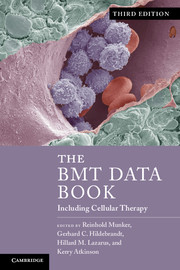Book contents
- Frontmatter
- Contents
- List of contributors
- Foreword
- Preface
- Acknowledgments
- Section 1 Basic science
- Section 2 Hematologic malignancies
- Section 3 Solid tumors
- 12 Therapeutic decision making in BMT/SCT for nonseminomatous germ cell tumor of testis
- 13 Therapeutic decision making in BMT/ SCT for renal cell cancer
- 14 Therapeutic decision making in BMT/SCT for soft tissue sarcomas
- Section 4 Nonmalignant disorders
- Section 5 Cellular therapy
- Section 6 Practical aspects and procedures
- Section 7 Complications
- Section 8 The BMT/SCT pharmacopoeia
- Section 9 HLA-testing and laboratory medicine
- Appendix Guide to the internet and literature databases relevant for BMT/SCT
- Index
- References
13 - Therapeutic decision making in BMT/ SCT for renal cell cancer
Published online by Cambridge University Press: 05 August 2013
- Frontmatter
- Contents
- List of contributors
- Foreword
- Preface
- Acknowledgments
- Section 1 Basic science
- Section 2 Hematologic malignancies
- Section 3 Solid tumors
- 12 Therapeutic decision making in BMT/SCT for nonseminomatous germ cell tumor of testis
- 13 Therapeutic decision making in BMT/ SCT for renal cell cancer
- 14 Therapeutic decision making in BMT/SCT for soft tissue sarcomas
- Section 4 Nonmalignant disorders
- Section 5 Cellular therapy
- Section 6 Practical aspects and procedures
- Section 7 Complications
- Section 8 The BMT/SCT pharmacopoeia
- Section 9 HLA-testing and laboratory medicine
- Appendix Guide to the internet and literature databases relevant for BMT/SCT
- Index
- References
Summary
Introduction: scientific rationale
Kidney cancer accounts for approximately 3%–4% of all malignancies in adults. The major histological type of RCC is clear cell carcinoma, which makes up about 70% of all spontaneous cases. Less frequent histological types are papillary RCC and chromophobe RCC. The clear cell type of RCC has a high frequency of mutations in the von Hippel–Lindau (VHL) gene, which functions as a tumor suppressor. As a consequence of VHL inactivation, a large number of genes that contribute to the tumorigenicity of clear cell carcinoma may be overexpressed, including vascular endothelial growth factor (VEGF). Metastatic RCC has a poor prognosis (mean survival between six and 24 months), and unlike many other solid tumors, is largely unresponsive to cytotoxic chemotherapy. Over the last seven years, there has been a dramatic increase in the number of therapies available to treat this malignancy, largely composed of drugs that target specific angiogenic pathways and mammalian target of rapamycin pathways. These agents can improve PFS and OS but result in tumor regression in only a minority of patients, with drug resistance and tumor progression ultimately occurring.
Unlike most solid tumors, RCC appears to be immunogeneic, expressing antigens that may be a target for the immune system, including but not limited to GP75, RAGE1, PRAME, CAIX, and antigenic molecules derived from a human endogenous retrovirus type E (HERV-E). In rare instances, spontaneous remissions are observed. In 10%–20% of patients, immunotherapy with IL-2 and IFN-α leads to remissions or the regression of metastatic lesions. The observation that this tumor is immunoresponsive led to studies exploring the susceptibility of RCC to a graft-versus-tumor (GVT) effect following allogeneic HSCT (Bregni et al., 2011; Childs et al., 1999; Tykodi et al., 2011). Here the outcome and status of studies investigating allogeneic hematopoietic SCT as immunotherapy for RCC are discussed.
- Type
- Chapter
- Information
- The BMT Data BookIncluding Cellular Therapy, pp. 146 - 158Publisher: Cambridge University PressPrint publication year: 2013



